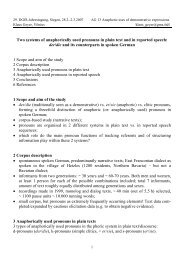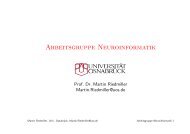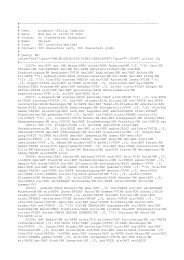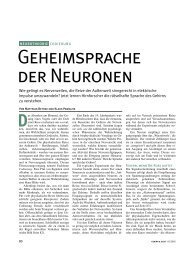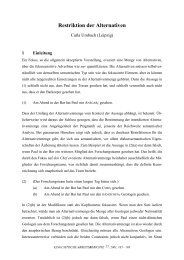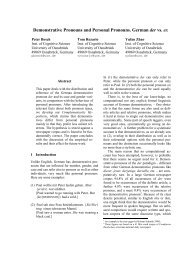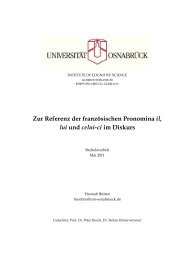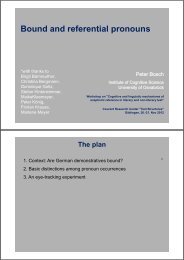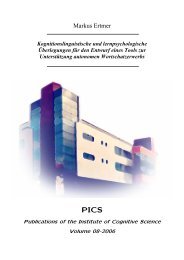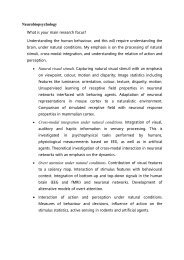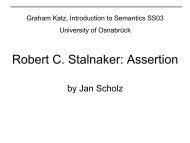Proceedings of the 6th Annual Meeting of the - Heinrich-Heine ...
Proceedings of the 6th Annual Meeting of the - Heinrich-Heine ...
Proceedings of the 6th Annual Meeting of the - Heinrich-Heine ...
Create successful ePaper yourself
Turn your PDF publications into a flip-book with our unique Google optimized e-Paper software.
COORDINATION OF WORD PARTS: A SURFACE LEVEL ACCOUNT<br />
Ron Artstein<br />
Rutgers University<br />
Abstract<br />
Coordination <strong>of</strong> parts <strong>of</strong> words is not reducible to coordination <strong>of</strong> whole words: while any<br />
group in <strong>the</strong> extension <strong>of</strong> orthodontistsand periodontistsmust include at least two orthodontists<br />
and two periodontists, <strong>the</strong> denotation <strong>of</strong> ortho and periodontists includes groups with<br />
just one specialist <strong>of</strong> each kind. The contrast follows from a surface level interpretation <strong>of</strong><br />
[ortho and perio]dontists. Individual word parts receive meanings through phonological decomposition:<br />
<strong>the</strong> conjuncts ortho and perio denote strings <strong>of</strong> sounds, and <strong>the</strong> remnant dontists<br />
is a function from sounds to word meanings that recovers <strong>the</strong> meaning <strong>of</strong> <strong>the</strong> whole<br />
word. The coordinate constituent [ortho and perio] denotes a plural object, and plural dontists<br />
licenses a cumulative inference, so one orthodontist and one periodontist are ortho and<br />
periodontists. The semantics also interprets ungrammatical strings like *cran and strawberries<br />
and *peri and telescopes, but <strong>the</strong>se are ruled out on phonological grounds.<br />
1 Introduction<br />
In this paper I argue that <strong>the</strong> correct interpretation <strong>of</strong> coordination <strong>of</strong> parts <strong>of</strong> words, as in (1)<br />
below, requires a semantics that interprets coordination at <strong>the</strong> level <strong>of</strong> <strong>the</strong> visible string; this entails<br />
<strong>the</strong> need for separate meanings for <strong>the</strong> word parts ortho, perio,anddontists (an orthodontist<br />
corrects irregularities in teeth; a periodontist specializes in gums and supporting structures).<br />
(1) ortho and periodontists<br />
The paper develops such a semantics, which is based on <strong>the</strong> principle <strong>of</strong> phonological decomposition<br />
(to be defined shortly); it explores <strong>the</strong> consequences this has on our understanding <strong>of</strong><br />
<strong>the</strong> semantics <strong>of</strong> conjunction, as well as phonological constraints on coordinate structures below<br />
<strong>the</strong> word level.<br />
The evidence that interpretation has to be at surface level comes from plural morphology. Specifically,<br />
<strong>the</strong> NP ortho and periodontists is not synonymous with orthodontists and periodontists.<br />
Suppose that Bill is an orthodontist and Martha is a periodontist; <strong>the</strong>n sentence (2) below has a<br />
reading on which it is true, whereas sentence (3) does not have a true reading.<br />
(2) Bill and Martha are ortho and periodontists.<br />
(3)#Bill and Martha are orthodontists and periodontists.<br />
This paper includes material that was presented at TLS-2001 at <strong>the</strong> University <strong>of</strong> Texas, Sinn und Bedeutung 6<br />
at <strong>the</strong> University <strong>of</strong> Osnabrück, <strong>the</strong> conference on Coordination: Syntax, Semantics and Pragmatics at <strong>the</strong> University<br />
<strong>of</strong> Salford, and to <strong>the</strong> Rutgers semantics group. Conference travel support from <strong>the</strong> Graduate School—New<br />
Brunswick is gratefully acknowledged. I owe particular thanks to Rajesh Bhatt, José Camacho, Sandy Chung, Veneeta<br />
Dayal, Paul Dekker, Beto Elias, Manuel Español Echevarría, Caroline Heycock, Markus Hiller, Hilda Koopman,<br />
Manfred Krifka, Alec Marantz, Cécile Meier, Alan Prince, Bo˙zena Rozwadowska, Philippe Schlenker, Roger<br />
Schwarzschild, Mark Steedman, Hubert Truckenbrodt, Karina Wilkinson, and Ede Zimmermann. The responsibility<br />
for <strong>the</strong> views expressed in this paper, as well as any resulting inadequacies, is <strong>of</strong> course my own.<br />
1



